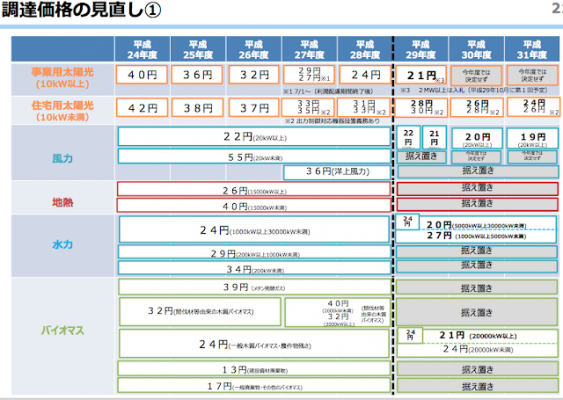A Brief History of Renewables in Japan
Posted by Eswar Mani August 13, 2020

Japan’s renewable energy program started in 2012, as a direct response to the March 11th, 2011 Earthquake. The ensuing nuclear disaster posed to the then ruling Democratic Party of Japan that over-reliance on nuclear was unreliable and unsafe. They started the Renewable Energy Feed-In Tariff (FIT) Program in June 2012. This FIT program provided a Japanese government-backed assurance to the electric utilities (TEPCO, Kansai Electric, etc) to purchase solar, wind, geothermal, and biomass energy at a significant premium to the market price. This subsidy spurred the industry. Wholesale markets electricity price is ~JPY8/kwh during a normal year, and we pay for home electricity bills JPY20+/kwh. The first year of the solar feed-in tariff program assured that solar plants would receive a JPY40/kwh tariff.
Subsidies spur industry, the significant amount of excess pricing on this tariff, in my opinion, attracted the wrong crowds to the solar industry. 地上げ屋, who made money in the real estate bubble in Japan of the 80s, started amalgamating land and applying for the Feed-in Tariff. I would call many of the development plots spurious since one would not be able to build solar at all (e.g. trees shading solar farm reduces capacity, no appropriate permits for construction).
Furthermore, in other countries, when the government grants a FIT certificate or any approval, there is a quality check procedure. In this case, anyone who applied for the FIT permit received it, even if they didn’t have access to the land or funding. As a result, some people held the land, while other people held the permits, and there was a significant amount of demand for solar FIT (90GW), but what was able to be created was only ~35GW.
Finally, because of the robust FIT subsidy (2012 JPY40/kwh vs JPY20/kwh), developers could ask construction companies to slice of mountains to build a solar farm. Flat land is a scarce resource in Japan, which is crucial to a large solar farm. The initial subsidy was so robust that hills, mountains, and trees were all chopped down to make way for development. The local municipalities, construction companies, and national government were starving for cash after the economy fell in 2011, so allowed for corners to be cut.
In summary:
1) Subsidies attracted market entrants who tarnished the reputation of the renewables industry.
2) Japanese government’s execution of the FIT program was poor.
3) No consideration for natural destruction
We dealt with the market participants by performing a background check and reputational check on all our counterparties. As the government’s quality check was lacking, we spent significant resources on due diligence for each aspect of the renewable energy asset. When building renewable energy projects, we also ensured that our stakeholder assessment map and environmental considerations were more robust than the government and part of global best-in-class methods, so we would not even inadvertently cause natural destruction. This meant we needed to follow our investment criteria.
Blog
Japan